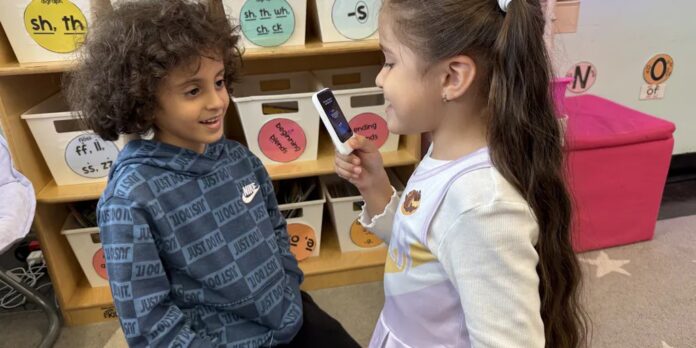Across the United States, schools are increasingly turning to artificial intelligence (AI) technology to help bridge the communication gap for students learning English as a second language (ESL). From walkie-talkies that translate spoken words to smart glasses that decipher conversations, these tools are aiming to create more inclusive learning environments.
This shift comes as the number of ESL students in the U.S. has surged past 5 million, highlighting the growing need for innovative support systems within our education system. While dedicated ESL programs remain crucial for long-term language development, AI is emerging as a valuable short-term solution to foster immediate participation and understanding.
Imagine a first-grade classroom in New York City. A young student, new to the country from El Salvador, uses a Pocketalk device to translate her question about a math problem to her classmate. Meanwhile, in Virginia, a father registering his daughter for school wears smart glasses that translate his Spanish into English for the school secretary. These scenarios illustrate the expanding role of AI in classrooms across the nation.
Teachers like Madison Weidner at P.S. 142 Amalia Castro in New York City are seeing firsthand the positive impact these tools can have. With about a third of her 22 students receiving ESL services, she’s found that AI-powered translation devices and online learning platforms with built-in translation capabilities significantly enhance student engagement and comprehension.
“They’re not only participating in conversations with their peers but now they’re able to hear the gist of a lesson as well,” Weidner explains.
Previously, she relied on hand gestures and limited communication, often missing key details vital to her students’ learning journey. Tools like Pocketalk and Pear Deck, which provides real-time translation during online lessons, empower ESL students to actively participate in class discussions and grasp complex concepts more readily.
Becky Huang, a professor of multilingual language education at Ohio State University, emphasizes the importance of respecting students’ native languages while providing support for English acquisition.
“You want students to be able to leverage their native language,” she states. “Otherwise it’s sink or swim, which is not a good approach.”
However, educators and AI experts acknowledge potential pitfalls associated with these technologies. Data privacy concerns, inherent biases within AI algorithms, and over-reliance on translation tools are significant challenges that need careful consideration.
Keith Perrigan, superintendent of Washington County School District in Virginia, highlights this balance. While his district utilizes smart glasses to facilitate communication between Spanish-speaking parents and school staff during registration, they prioritize ESL students’ immersion in English instruction within the classroom.
“Our number one goal is getting them fluent in reading, writing and understanding English as quickly as possible,” Perrigan explains.
Victor Lee, who leads Stanford University’s AI+Education accelerator, stresses the need for responsible implementation:
“On the one hand, it’s encouraging because it has the potential to increase participation and learning opportunities when differences in language are creating difficulty for them,” he says. “On the other side of it, I would hope as this technology gets used, it’s done so with caution and awareness of major limitations that exist…It’s considered one type of support for working across languages but there are many others that absolutely should be part of teachers’ repertoire.”
Weidner underscores the imperfect nature of current AI translation technology. She observes instances where translated words don’t make sense in context or when the system struggles to understand softer-spoken voices, particularly common among shy ESL students. These limitations highlight the need for ongoing refinement and development within this field.
Lawrence Paska, executive director of the American Council on the Teaching of Foreign Languages (ACTFL), adds another layer of complexity: AI-powered translation often lacks the cultural nuance and context crucial for truly effective communication.
The ACTFL advocates for training educators on best practices for using AI tools in language learning while acknowledging their evolving nature. They recognize that while these technologies hold promise, they shouldn’t replace essential human interaction and culturally sensitive instruction.
As schools navigate this new technological landscape, finding the right balance between leveraging AI’s potential and preserving core educational values remains a critical challenge. Striking that balance will ensure that technology empowers ESL students to learn English effectively while respecting their cultural identities and fostering genuine communication within diverse classrooms.

































































